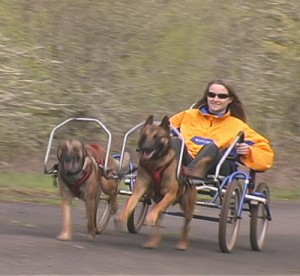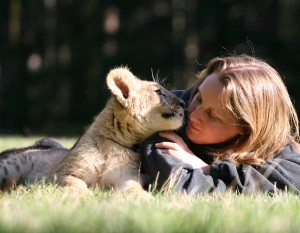I am asked about Cesar Millan fairly regularly, generally by novice dog owners who are curious as to whether I recommend his show and techniques. This is a reasonable question since Cesar Millan is perhaps the most recognizable and influential dog trainer ever: millions of people watch his show and listen to his advice on how to address behavioral issues with their dogs. Yet many of the most respected experts in the field consider his techniques to be harmful to dogs, ineffective, and destructive to relationships.
So, what is the truth? There is no single right answer about how to train animals. We all have opinions, and most of us are certain we know the best way and everyone else is wrong! Most trainers are very good in some areas and less good in other areas. And we all have different goals–one trainer may be much better at helping you achieve a particular objective while another trainer may be much better at something else.
I do not know Millan, and can only comment on what I have observed on television. People are entitled to like Millan’s methods–many people do! And it would be hard to fault his business and marketing savvy… I am not judging anyone’s opinion, merely sharing mine:
I think Cesar Millan is a first-rate bully and a fifth rate trainer. While he does some things well, and offers some excellent advice, in aggregate I do not like what he does to most of the animals with which I have seen him work. He is uninformed, unimaginative, cruel, and absurdly coercive. The fact that his bullying sometimes works at least temporarily does not make it less offensive. In my opinion he has hurt far, far more dogs and relationships than he has helped, and of the ones that he has helped, I suspect the recidivism rate is extremely high. He has set dog training back decades. He is dangerously irresponsible. (For example, one person taking 30 dogs off leash to a dogpark ought to be a felony in my opinion)
Let me start with what I like about Millan’s message: exercise, calmness, and leadership. I absolutely agree that a huge portion of the behavioral issues people see in their dogs can be ameliorated through increased exercise and mental stimulation. Canids evolved to spend a large portion of their lives active and challenged, and sticking them in a room all day with rich foods and little exercise leads to many problems. I also agree that canids thrive in an environment with clear boundaries and a calm and strong leader. This allows them to be relaxed and confident and know how to behave. I also recognize that many average pet homes want a dog that is as “shut-down” as possible: they do not want a happy, curious, and confident pet, they want a pet that just lies quietly in the corner, and Cesar’s techniques are in many instances an effective path to that end.
Now to the negatives about Millan’s techniques:
- Impatient: Millan often takes little time to get to know the dog, or to teach it what is desired, or to build a relationship, he simply grabs the dog, puts it into the situation where it is known to have problems, and then corrects it for failure. In most cases, good training is just the opposite of this. You find situations in which the dog can succeed, and then you gradually increase the difficulty of the situation while rewarding the dog for success at each step. Good training is often almost invisible.
- Correction first: Millan often hits, chokes, kicks, drags, and electrocutes dogs that do not yet know what is being asked of them as part of a systematic routine of intimidation. There are several steps that should occur before correction: it is very rarely effective to correct or punish a dog that does not yet understand what you are asking. In many instances Millan could work the dog a little further away from a particular stimulus and teach the dog how to succeed and then get closer, but instead he rushes up, lets the dog fail, and then corrects the heck out of it. This may create good TV drama, but it is patently not in the dog’s best interests.
- Micromanaging: Millan often keeps the dogs on such a short leash (literally and figuratively) that they do not learn accountability. They do not learn to make the right choices and respect the rules, they simply learn to give up and shut down. They learn to do and try nothing because they will get attacked if they move. Good training allows dogs to feel empowered and instructed; to clearly understand what behaviors are not allowed, and be responsible for making the right choices.
- Confrontation: Millan routinely creates confrontation where it does not naturally exist. This was a popular notion in the 50s—you cannot really train a dog until you have shown it that you are the boss by kicking its butt, so you should make this happen—set up the dog to fail without any training, just so that you can induce a confrontation that you can then win and make sure the dog knows you are stronger, bigger, and tougher. Good trainers absolutely may do this with some animals, but it is fairly rare, and Millan seems to want to go there with almost every dog.
- Unimaginative: Millan sometimes uses different tools, but his basic range of techniques is very narrow. So when he happens to get a dog that needs those techniques he will be very effective, when he happens to get a dog that needs something different he will be very destructive. I would have the same problem if he were purely positive and gave treats for everything—one technique does not work across the board. Good trainers are fabulous problem solvers. They come up with brilliant ways to induce behaviors, change attitudes, and mold responses. They have a remarkable range of techniques that they use to work with different dogs. They can be very positive when needed, very harsh when needed, supportive, quiet, loud, calm, exuberant, etc.
- Cruel: Millan chokes dogs till they pass out and he electrocutes them repeatedly until they are biting and terrified. The American Humane Association who monitors animal use on set has requested that Nat. Geo not air some Dog Whisperer episodes because the treatment of the animals is so inhumane. Good training is never cruel.
- Archaic / Uneducated: Millan’s training is essentially exactly what one would have seen in 1950. But then, what educational background does Millan have? How many of the relevant books has he read? Has he made any real effort to learn what others know so that he can improve? Or is he just reinventing unrefined and simplistic dog training? We have learned so much in the last 50 years that it is hard to imagine someone who would not integrate some of that learning into their training. Good trainers avail themselves of available knowledge and science and continually improve. Even the best trainers in the world often attend each others seminars, but I have never seen Cesar…
- Isolation: I am not a huge fan of competition with animals, but occasionally it can be useful to objectively assess how your techniques are working. Entering an obedience trial, or agility or Schutzhund or whatever, lets you gauge your performance against your peers. Cesar not only does not compete, he has never, so far as I know, tried any canine competition so he could see where he stands.
- Indifference to canine attitude: Millan sacrifices attitude for quick superficial results, and I believe that is very counterproductive. Watch any of the dogs he works, and you will rarely see truly happy dogs, confident dogs, secure, trusting dogs. Good trainers focus on attitude and character—training rules and specific behaviors is essentially trivial. Once you have taught a dog how to learn, how to take cues, how to relax, it is easy to teach specific behaviors.
Adding all of this together, I find Millan’s relationship with the dogs unappealing—I do not see trust, respect, confidence, and adoration, I see subservience, temerity, and learned helplessness.
Millan fans sometimes suggest that those who dislike Millan must be softies who reject notions of control and discipline. It is absolutely true that some people who dislike Millan do so because they dislike any sort of correction. However, there are also many, many excellent trainers who do believe in appropriate corrections but who revile Millan’s techniques. Virtually all good trainers impose rules, boundaries, and limits. Some excellent trainers even use strong corrections when they are appropriate. Go to any canine competition (obedience, French Ring, agility, herding, etc.) and ask around, you will generally find the top people with the best trained and most obedient dogs dislike Millan’s methods, while hordes of novices with unruly dogs are devotees. Some of the most accomplished trainers in the world dislike his methods, and I assure you their dogs are not disobedient or disrespectful.
I do not understand why many people equate control with intimidation. Abusive parents who beat or terrorize their children may achieve “control.” So do reasonable parents who set and explain clear boundaries, teach and reward desired behaviors, earn respect and trust, and effectively utilize punishment when necessary. These good parents or dog trainers absolutely may use intimidation when it is the best option, but it is not the foundation of their relationship—it is not where they start or how they interact most of the time. (I vividly remember the few times my father seriously intimidated me, and they were hugely effective in large part because they were not frequent!)
Perhaps the best place to observe the dichotomy between dominance based training and cooperation based training is in training any wild animal. Work with a tiger, a grizzly bear, a pack of wolves, an orca, or even a raccoon or squirrel, and you quickly discover that these schools of thought are NOT the same. Dominance based trainers exert a clear and absolute dominance every moment of interacting—it is imperative that the animal understands that humans have absolute power and should never be challenged. Non-dominance trainers exert a clear and absolute cooperation every moment—it is imperative that the animal understands that humans are their friends and are not going to challenge them or hurt them. While a single trainer may utilize both attitudes at different times, if you switch back and forth with these animals, you have a VERY short career—suddenly showing weakness to a wild animal that has been dominated, or suddenly showing dominance to a wild animal used to cooperation generally elicits extremely undesirable results… Each attitude can be powerfully effective, but they are essentially different in far more than language. (I think it is important to concede that even many of the most cooperative trainers do have a line that cannot be crossed. A point at which dominance training does come into play. A point at which they say, “You have no choice here, you must do what I say.” The critical distinction is that they strive to help the animal avoid crossing that line, rather than regularly luring the animal across that line so that they can have an “opportunity” to dominate and intimidate some more…)
If your primary method of control is intimidation, the animals you train learn that intimidation and power are tools to get what you want. Sooner or later these animals may well decide to try to get what they want using intimidation. This is what happens eventually to most animal bullies in the wild, and is extremely dangerous. So I elect to use cooperation and leadership so that they learn that I am a powerful and benevolent leader who will help them get what they want in the world. I outsmart them by making sure that their success coincides with my desires until they reflexively and habitually do what I ask. I am smarter, but not stronger or faster, so it makes sense to use my intellectual advantage rather than bluffing about a physical advantage.
There is a genuine distinction between a leader who is revered and idolized and a leader who is feared, and I personally believe that being revered leads to better working, more reliable, happier, healthier dogs, but I rarely see this occur on Millan’s show. I see bullying and intimidation instead of leading and teaching.
It makes me profoundly sad to think that such a bully is out there working with dogs every day, but far worse is that so many people do not see his techniques for what they are. That millions of people still see intimidation and cruelty as viable leadership techniques makes me sad indeed.

















